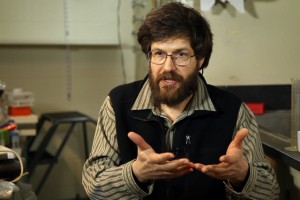Cognitive-Enhancing Drugs
Neuropsychologist Barbara Sahakian on episodic memory, the symptoms of schizophrenia, and the drugs used in Al...
How can genetically identical cells play different roles in an organism? Why is chromosome inactivation needed, but can be potentially dangerous? Assistant Professor at Harvard Medical School Alexander Gimelbrant talks on the surprising ways in which gene expression can be regulated.
We’re starting as a one cell, as a zygote, and then some cells know that they’re liver cells, and some cells know that they’re brain cells, and some cells know that they’re lymphocytes and so forth, and they remember their state. Then some whatever outlier cell has gone crazy and is becoming a cancer. So, again, this is a state, so genomically they could be absolutely identical, but they have very, very different programs running through them and they have different memories of what their identity is.
An extra copy of a single chromosome can lead to very drastic states. For example, Down’s syndrome is an extra copy of chromosome 21, it’s trisomy 21. So having basically an extra copy of an X chromosome, which is much larger than chromosome 21, could be pretty dangerous. So what happens, in fact, is that women just like man have essentially one active copy, because one copy is turned off. Sometime early in the development what happens is that both X chromosomes are active at some point and then a decision is made, as these early pluripotent cells divide, and differentiate, and become specific tissues, the cells make a decision. So one cell says: ‘Okay, I will turn off the paternal X chromosome’ and then all its progeny, every cell that results from it, remembers that decision and the same chromosome is off everywhere. And another cell decides: ‘Oh, I will turn off the maternal chromosome’, and again, this decision is very stable over any number of cell divisions and propagates.
So to make a long story short, the answer is that 10 to 15 percent of genes are showing that type of regulation in a given cell type. Actually almost any reasonable question is open right now, because it’s something that is completely new, people haven’t expected this to happen. So we don’t know what the mechanisms are, we don’t even fully know if it’s one mechanism for all of these hundreds or thousands of genes, we don’t know when that happens in the development. So we know when X inactivation happens, we don’t know when this happens. We don’t know what is the real function of this. And then finally we don’t know how to manipulate this.

Neuropsychologist Barbara Sahakian on episodic memory, the symptoms of schizophrenia, and the drugs used in Al...

What technologies are helping fight incurable diseases today? What breakthroughs will help humanity defeat can...

Biologist Konstantin Khrapko on genes that regulate the aging program, genome of a nematode, and the effect of...